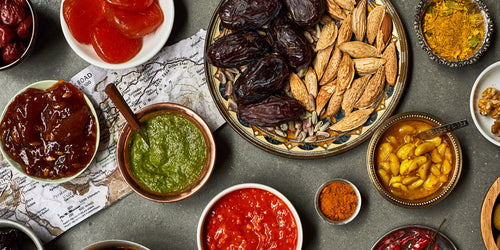Your Cart is Empty
Utmost respect to all your aunties, but Chitra Agrawal makes the best achaar you’ll ever eat. Sorry, we don’t make the rules. But her Brooklyn Delhi line of Indian pickles are in a class all their own: resplendently spiced and balanced, with enough brightness to cut through the richest stews, and a much more tempered saltiness than other commercial brands. They come in tomato, roasted garlic, and rhubarb variations, and work just as well on avocado toast as on a thali. Later this year, Agrawal will release a line of simmer sauces perfect for one-pot meals. And like everything else she creates, they’ll be based in Indian cooking tradition, but not circumscribed by it.
Before she was a condiment maker, Agrawal was a blogger under the handle ABCD: “American-born Confused Desi.” She launched the blog in 2009 as a way to explore her Indian-American heritage, and to teach herself the fundamentals of her parents’ favorite foods while adapting them to her unique second-generation circumstances as a Jersey kid living in Brooklyn. ABCD’s of Cooking, as the ten-year old (!) blog is now called, led to a cookbook, Vibrant India, which dishes up traditional South Indian vegetarian recipes alongside apple-ginger-coconut hand pies that owe equal creative debts to Hindu religious festivals and McDonald’s drive-thrus.
As a writer, cooking instructor, and prolific Instagrammer, Agrawal encourages her audience to make Indian cooking their own. Her recipes frequently stray from tradition, such as mixing whole grains into rice dishes for varied flavor and texture, and incorporating farmers market finds into lentil dishes. We dig that approach, especially when it results in a cauliflower-and-pickle-topped hot dog that’d make even the most jaded Jersey hot dog fan take notice. Follow along as Agrawal guides you through building an Indian pantry from the bottom up. It’s really just the beginning, but once you’re stocked up, you'll be cooking Indian feasts in no time. — Caravan eds.
Chitra’s Indian Essentials
Asafetida
When you smell asafetida, it’s super pungent, but when it’s fried it adds a leek or garlic flavor, and a bit of umami to dishes. A lot of people say, “I cooked this recipe, but it doesn’t really taste like Indian food.” I ask if they added asafetida, and they admit they left it out. That’s why! When I first heat my oil, I throw in asafetida and let it sizzle for a few seconds to season the oil. Shop asafetida.
The Southern spices
My mom is from South India and my dad is from the North. In the South, some of the main spices along with asafetida are black mustard seeds, curry leaves, and dried red chile peppers. If you add those to hot oil with asafetida you can make so many of the dishes from my mom’s family—seasoned rice, stir fries, salads, and dals. Fresh curry leaves are your best option, and they freeze well. Dried leaves aren’t as strong, so I’d use double the amount that a recipe calls for. Shop black mustard seeds, curry leaves, and red chiles.
The Northern spices
On my dad’s side, we’d mix in whole cumin seeds, maybe nigella or bay leaves along with onions, ginger, garlic, and fresh green chile peppers, coriander powder, garam masala, and then build flavors from there. My dad mostly uses whole cumin seeds, not ground, but he’ll sometimes sprinkle roasted ground cumin over raita. He’s the yogurt maker in the family.
Achaar
Growing up, we’d finish every meal with rice, yogurt, and a little achaar, sometimes referred to as Indian pickle. That combo is still my comfort food. Achaar is a staple Indian condiment that is used to add a spicy, sour, savory and sometimes sweet kick to meals. For the most part in many achaars, salt, oil and spices like turmeric preserve the fruit or vegetable. Often achaar is made from green mangos or limes. In India, you will find different varieties made from all sorts of regional produce and oils. For instance, in the South, sesame oil is used while in the North, mustard oil is used in many recipes. Shop Brooklyn Delhi achaar.
Turmeric and garam masala
Both sides of my family use turmeric, but only a little bit! When I see recipes that call for two tablespoons of it, I say to myself, “oh no.” It’s the same for garam masala, a spice mix which is used in a lot of dishes in the North. In my family we only use about ¼ teaspoon at a time; it should be an accent, not the main flavoring. If you were to taste one of my father’s curries, it has a lot of flavor, but it’s never heavy-handed. Shop turmeric and garam masala.
Urud and chana dal
These are two lentils used in South India in a variety of ways. The most interest way I think is that they are fried in oil to impart a nutty flavor and crunchy texture to rice and vegetable stir fries. Urud dal are small and cook quickly; chana dal, which are like split peas, require more attention to cook them without burning, so I usually recommend people start with urud dal, then work their way up to using both. Shop urud dal and chana dal.
Rasam and sambar powder
Rasam is a spicy and sour South Indian lentil soup that our family makes with tomatoes, tamarind and toor or red lentils. It’s a staple and paired with rice and sometimes just sipped alone. Rasam powder recipes differ from family to family but I make mine with coriander seeds, cumin seeds, black mustard seeds, fenugreek seeds, peppercorns, cinnamon, curry leaves, dried red chile peppers, asafetida, and turmeric powder. Similarly, sambar, a spicy lentil and vegetable stew is also a staple in South India. I make my sambar powder from urud dal and chana dal, coriander seeds, dried red chili peppers, cinnamon, curry leaves, coconut, fenugreek seeds, and turmeric. I sometimes use rasam or sambar powder to also flavor different stir fry dishes called palya made from green beans, beets, or cabbage finished with lemon, coconut and fresh cilantro. Shop rasam powder and sambar powder.
Unsweetened coconut
I buy unsweetened shredded coconut that is either dried or frozen fresh for adding to lentils, rice, and stir fry dishes. Plump up dried coconut with hot water before you cook with it. Shop unsweetened coconut.
Lots of legumes
I’m vegetarian and grew up eating all kinds of lentils and beans. We ate kidney beans and chickpeas a lot, and then so many lentils. There’s masoor dal, which are a red lentil that is split and skinned, and whole masoor dal; split moong dal; and whole moong dal, which you can sprout. It’s all about different textures. If I’m feeding my baby, I’ll cook more skinned lentils, since they’re easier to digest. Shop dried beans and dried lentils.
Basmati rice (and then some)
It’s not done traditionally, but I like to mix up grains, like cooking a 50/50 mix of rice and quinoa, or millet or farro. For rice, I prefer Dehraduni variety basmati, unless I’m making idli where I use a short grain variety. I just love the fragrance of basmati; stuff like ‘Texmati’ in supermarkets just doesn’t cook the same. For both rice and lentils, it’s really important to rinse them before cooking. I’ll rinse my rice until the water runs clear, then soak it in fresh water for half an hour and discard the soaking liquid. It helps the grains cook evenly, and it’s easier on your digestion, too. Shop basmati rice.
Hot mix
I love hot mix, which is kind of like Indian Chex Mix. It’s a mixture of fried or roasted tasty things like nuts, lentils, chips all flavored with a spicy masala. We put hot mix in sandwiches for crunch and sprinkle it over vegan hot dogs. Growing up my dad and I would put it on buttered toast, which was so good. I also love boondi, which are little chickpea flour puffs. I put those on salads like croutons. Shop hot mix and boondi.
Curd chiles
These are chiles cured in salt and buttermilk; my mom just brought some back for us from India, and we’ve been using it on popcorn. My husband Ben isn’t Indian, but he’s getting there with his cooking. He makes all the popcorn in our home, and he’ll toss the popped kernels with butter seasoned with asafetida, mustard seeds, curry leaves, and curd chiles. Then he’ll finish it with nutritional yeast, so it’s the most savory thing. Shop curd chiles.
Atta
Chapatis, or roti, are such a staple in North Indian homes, and this is the flour you use to make them with. You can also use atta to make other breads like puri, paratha, kachodi, etc. It makes this nice soft dough with...it’s hard to describe, but I start drooling just thinking about my dad’s hot chapati spread with ghee. They just melt in your mouth. Shop atta.
Tamarind
This is one of the most used souring agents in Indian cooking along with lemons, limes, and amchoor powder (dried mango powder). When I make tamarind chutney, I’ll take a piece from a block of dried tamarind and soak it in boiling water for a it and then extract the pulp through a fine-meshed strainer leaving the seeds and skins behind. I boil this tamarind pulp with spices and jaggery for a perfectly tart, sour and spicy chutney. If I’m making a rasam or sambar which just needs a little tang, I will use prepared tamarind paste and just add a spoon. Shop tamarind pulp and tamarind paste.
Jaggery
One of my favorite ingredients. It’s made from pure sugar cane and sometimes referred to as medicinal sugar because it is unadulterated and still contains all of its original minerals and vitamins. You can buy it in a solid block or in smaller whole pieces. It’s quite hard so you have to grate it. It also comes granulated but whole is much better tasting. Jaggery is the main sweetener used in Indian desserts and its also used to add a bit of sweetness to some lentil dishes, chutneys and achaars. It has a rich molasses flavor that I like adding to my achaar and cookie recipes. Shop jaggery.
Cook like Chitra
Recipe: Curried Coconut Lentils
Recipe: Delhi Dawgs




















